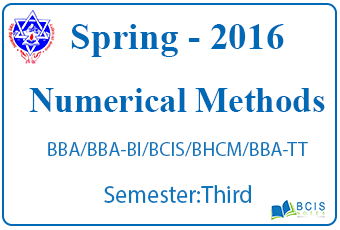
| Level: Bachelor | Semester – Fall | Year: 2016 |
| Programme: BCIS | Full Marks: 100 | |
| Course: Numerical Methods | Pass Marks: 45 | |
| Time: 3hrs. | ||
| Candidates are required to give their answers in their own words as far as practicable. |
| The figures in the margin indicate full marks. |
| Section “A”
Very Short Answer Questions Attempt all the questions. |
10×2 |
||||||||||||||||||||||||
| 1. | What are the errors in numerical methods? | ||||||||||||||||||||||||
| 2. | What are the bracketing and non-bracketing method? | ||||||||||||||||||||||||
| 3. | What is meant by ill-conditioning? | ||||||||||||||||||||||||
| 4. | Derive the Trapezoidal rule. | ||||||||||||||||||||||||
| 5. | Derive the formula for Laplace and Poisson’s equation. | ||||||||||||||||||||||||
| 6. | Does the following system have a unique solution or not?
X+2y=5 3x+y=5 |
||||||||||||||||||||||||
| 7. | Using the Picard method find the solution of dy/dx=1+xy up to second approximation where y(0)=0. | ||||||||||||||||||||||||
| 8. | Derive the formula for Newton’s Divided and difference. | ||||||||||||||||||||||||
| 9. | What is the initial value problem? Differentiate initial value problem and boundary value problem in brief. | ||||||||||||||||||||||||
| 10. | Distinguish between ordinary and partial differential equations. | ||||||||||||||||||||||||
| Section “B”
Descriptive Answer Questions Attempt any six questions |
6×10 |
||||||||||||||||||||||||
| 11. | Find the positive root of the equation corrects up to 5 decimal places using the Bisection Method. | ||||||||||||||||||||||||
| 12. | Using the power method, Find the largest Eigenvalue and corresponding Eigenvector of the following matrix. | ||||||||||||||||||||||||
| 13. | Fit a second-degree parabola to the following data:
|
||||||||||||||||||||||||
| 14. | The following table gives the velocity of an object at various points in time:
Find the acceleration of the object at t=2 Sec. Assume a suitable value for h. |
||||||||||||||||||||||||
| 15. | Solve the following equations by using the Dolittle method.
3x+2y+z=10 2x+3y+2z=14 X+2y+3z=14 |
||||||||||||||||||||||||
| 16. | Use Romberg’s method to compute correct to 4 decimal places. | ||||||||||||||||||||||||
| 17. | Solve initial value problem , y(0)=1 to find y(0.4) by using h=0.1. | ||||||||||||||||||||||||
|
18. |
Section “C”
Case Analysis The monthly faculty salary in three departments of an institute is given below. Assuming that the salary for a particular category is the same in all the departments.
i. Model the above problem into a system of a linear equation to determine the salary of each category of faculty. ii. Calculate the salary of each category of faculty iii. Write an algorithm to compute the above problem. |
20
|
|||||||||||||||||||||||
You may also like: Computer Architecture and Microprocessors || Fall 2017 || Pokhara University

Leave a Reply